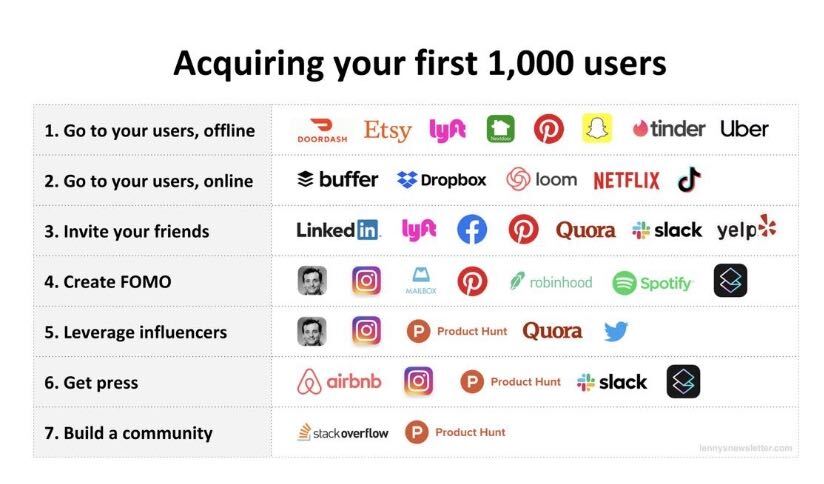What does Dropbox, Gmail and Foundr have in common? They all started with a brilliant marketing campaign well before releasing an Minimum Viable Product on the market. Growing from 0 to thousands of users overnight, their founders understood early in the process that marketing should not be optional and that deploying a few tactics well in advance might do even more than just generate some buzz.
While there are a dozen of Minimum Viable Product marketing tactics that you could deploy, in this article I won’t be listing them, as you will hardly ever find a secret formula that has worked for a brand and will definitely work for yours too.
Instead, I will encourage you to reflect on why making even a minimum effort in marketing is paramount for your startup. You should understand why you need a pre-launch marketing effort and why doing so will not only create awareness around your MVP, but also help you validate your idea just by measuring the interest generated by your campaign. Ultimately, you will (hopefully) use the drive that will come with reading this article to lay the foundation for a viral loop that has the potential to drive exponential growth for your product early in the process.
Building an Minimum Viable Product to validate your idea.
As strong advocates of the MVP, we guide each of our clients towards starting off with a minimum version of their digital product, instead of heavily investing into creating an overly-crowded experience, risking to misinterpret the real market-demand and lose momentum. The reason we do this is because we want them to reach product-market fit faster, ensuring that their digital solution truly complies to what the users need.
Building an MVP implies significantly less investment, as the product only consists of an essential set of features, incorporated in a visually-appealing design.
Nevertheless, MVP Feature Prioritization will yield much more value than just saving time and money. The users will have a shallow learning curve and in time, based on the feedback gathered from those early adopters, you will be able to gradually add extra features to your product, without risking to create a cluttered experience that will increase the users’ learning curve and ultimately alienate them from your platform.
"With the Minimum Viable Product reaching the market faster, a stream of valuable feedback will be ignited, which, in turn, will support you in validating your hypotheses and adapt the product to what the users need."

Your MVP is pointless if you don’t have anyone to use it. That's where marketing helps!
We often get into a lot of conversations about futuristic ideas, which might seem unlikely to get traction. Even so, because just like the iconic Steve Jobs, we believe that “Those who are crazy enough to think they can change the world usually do”, we normally suggest these clients to test their ideas even prior to launching an MVP.
How?
By turning to marketing as a relatively cheap (yes, you heard that right) vehicle to test their hypotheses.
We made it clear that launching an MVP will save you a lot of budget that you could then redirect in other crucial parts of the start-up such as business development and marketing. While it is a common belief that marketing has to be a costly activity, we tend to disagree. You could, indeed, pump a considerable amount of money into producing a cinematic video and buying a lot of media space, but you could also simply rely on actionable copy and a few behavioural psychology tactics to craft a landing page, an e-mail campaign, or a referral scheme.
We know that, if you are at the beginning of your journey, you might not have a dedicated marketing team. Perhaps you are struggling to make some efforts in this direction, whilst juggling between business development, product development and other parts of your startup which all seem crucial. But you should still aim to do it.
Why?
As a startup founder, committing to Minimum Viable Product marketing efforts prior to even launching the actual MVP will support you in establishing a solid user base. This community will function as an initial testing body of whatever crazy idea you have. While it might seem like a hassle, it is more a matter of doing some preliminary research and then going through a trial and error process to find out what works best for your product and what communicates the most value to the users you are trying to reach. Even more, doing so will help you ensure that the users that you want to target are the right ones. From Coca-Cola to Microsoft, we’ve seen a lot of businesses articulating distinctive solutions that failed to scale up due to targeting the wrong market. Although these major brands managed to bounce back and rethink their strategy consequently to such major failures, for a startup that does not benefit from such considerable budgets, a move like that could mean the end of the story.
"Pre-launch marketing will allow you to test your product without even having a product."
How marketing could deliver maximum results for your Minimum Viable Product?
Dropbox has made a name for its ingenious growth hack. Offering its early-adopters incentives for completing tasks, like sharing a file or referring other people to the platform, the creativity of this technique relied on gamifying the onboarding process. Even more, by gifting new users with more storage for linking their Dropbox account to platforms like Twitter or Facebook, they managed to grow exponentially with little to no investment, getting no less than 70.000 users overnight.
Foundr, on the other hand, turned to Kickstarter to validate their idea without having to invest ridiculous amounts of money into a pre-launch marketing campaign. Relying on the power of a crowdfunding platform, they decided to publish their first book there and fuel the buzz with a few relatively low-cost tactics like influencer marketing, social advertising and email marketing. Soon, Foundr reached their Kickstarter goal, attracting hundreds of backers and even more early adopters.
Although you can now create a Gmail account, actually numerous accounts without any hassle, when this platform launched, it used an invite-only system to drive growth. Back then, the product was a disrupting e-mail service, containing many of the features we now take for granted, but because it didn’t benefit from a considerable awareness, it needed a tactic to not only generate buzz around it, but quickly drive people towards starting to use the platform. The ingenious growth hack in this situation was based on the Fear-Of-Missing-Out, which is a technique useful to this day. In a matter of days, this tactic generated so much interest that invites were being auctioned on eBay.

Ready to take your Minimum Viable Product to the next level?
Just like the founders of these three businesses took their time to carry out clever marketing efforts even prior to having an actual product, as a start-up founder yourself you should follow their lead. Launching an MVP will support you in acquiring valuable feedback from the market and validate your initial hypotheses about the product and the customers you are targeting.
But how are you going to reach those early adopters and have them test your MVP if you are nowhere to be found?
Yes, taking a small fraction of time to develop a marketing strategy and execute it as a pre-launch campaign will get your product the awareness it needs to reach those first hundreds, or even thousands of early adopters. The best part is that you won’t have to invest too much money in it. Besides that, such pre-launch marketing campaign will add up to your crucial research efforts, since you will be able to gather feedback only by observing how your target segment will react to the messaging and content you will develop around the product.
You won’t be needing any ridiculous budgets or expensive tools. Just a solid vision and trust that even a minimum marketing effort should do the job. So why not give it a try? Gather your people around the table and let them think about the craziest marketing tactics to match your even crazier product idea.
"Gather your people around the table and let them think about the craziest marketing tactics to match your even crazier product idea."
🚀Ready to start working on your own MVP? Get in touch and let’s explore your product idea together!






